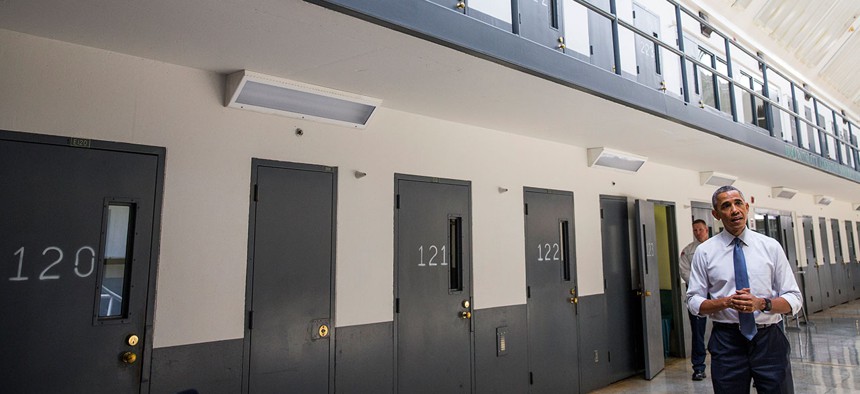
Barack Obama pauses as he speaks at Oklahoma's El Reno Federal Correctional Institution in July. Evan Vucci/AP
Obama's Executive Actions on Solitary Confinement in Federal Prisons
The president has announced new measures to reduce the use of restrictive housing in federal prisons.
President Obama has issued executive actions to ban the use of solitary confinement for juvenile offenders in federal prisons across the country.
Obama wrote in a Washington Post op-ed that ran in the Tuesday edition of the newspaper that solitary confinement is overused and can lead to dangerous psychological consequences.
“How can we subject prisoners to unnecessary solitary confinement, knowing its effects, and then expect them to return to our communities as whole people?” the president wrote. “It doesn’t make us safer. It’s an affront to our common humanity.”
The executive actions also prohibit wardens from using solitary confinement as punishment for inmates who commit “low-level infractions” inside prison walls, according to the White House. The measures call for an increase in number of hours solitary-confinement inmates spend outside of their cells; the expansion of alternative housing units for inmates with mental illnesses; the hiring of more staff psychologists; and policies that discourage wardens from putting inmates in solitary confinements during the last 180 days of their prison terms, “making it easier for inmates to adjust when they return to the community.”
“In America, we believe in redemption,” Obama wrote in the op-ed. “We believe that when people make mistakes, they deserve the opportunity to remake their lives.”
The reforms will affect some 10,000 prisoners held in restrictive housing in the Federal Bureau of Prisons, though, as The Post’s Juliet Eilperin points out, only a handful of juvenile offenders are placed in such housing each year.
The White House said the Bureau of Federal Prisons will begin publishing monthly data on solitary confinement use on the system’s website.
The actions six months after the president asked the Justice Department to review the use of solitary confinement in the federal prison system. They are part of a greater push by the administration for criminal-justice reform, which Obama has called a “bipartisan priority” for his last year in office.
Some states have recently lapped the federal government on solitary-confinement reforms. Last month, New York announced it would place one-quarter of the state’s 4,000 prisoners in restrictive units in less isolated housing, pursuant to a settlement with the New York Civil Liberties Union. In September, a California court ruling ended indeterminate-length sentences in restrictive housing, releasing almost all prisoners who spent more than 10 years in prolonged isolation, including more than 400 inmates in Pelican Bay State Prison, into the general inmate population.
As my colleague Matt Ford has noted, no one knows exactly how many people are currently kept in isolation in the United States, in both state and federal correctional facilities, as official nationwide counts don’t exist. The most commonly cited figure is 80,000.







